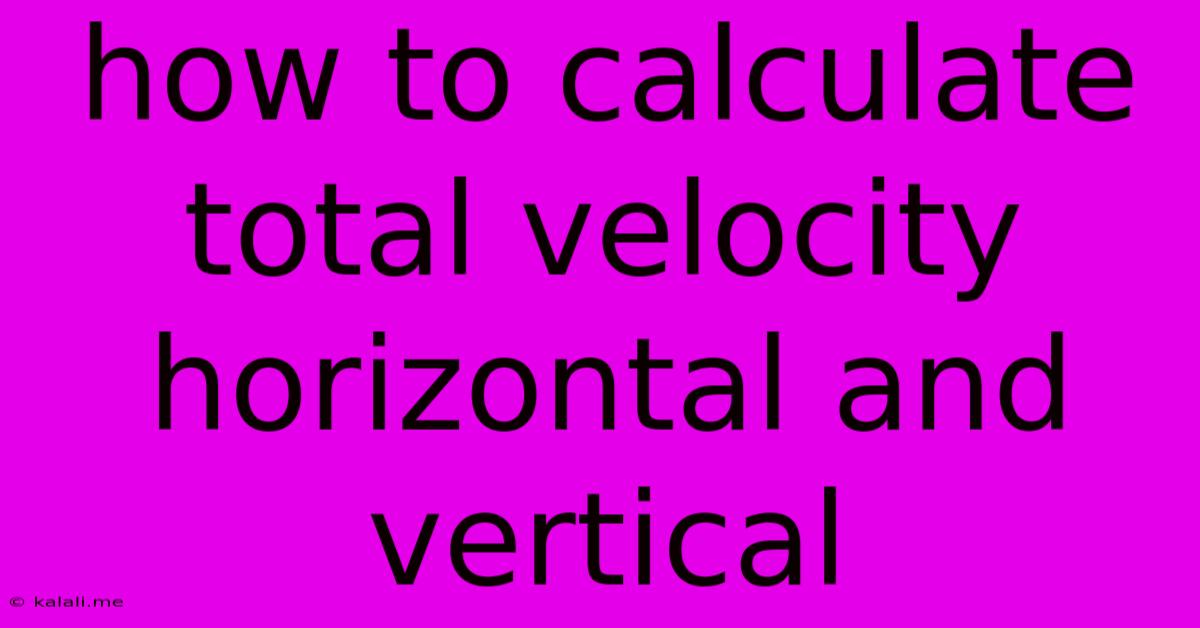How To Calculate Total Velocity Horizontal And Vertical
Kalali
May 23, 2025 · 3 min read

Table of Contents
How to Calculate Total Velocity: Understanding Horizontal and Vertical Components
This article will guide you through understanding and calculating total velocity, breaking it down into its horizontal and vertical components. Understanding these concepts is crucial in physics, particularly in projectile motion problems. We'll explore the formulas and provide practical examples to solidify your comprehension.
What is Velocity?
Velocity is a vector quantity, meaning it has both magnitude (speed) and direction. Unlike speed, which only tells us how fast something is moving, velocity tells us how fast and in what direction it's moving. In two-dimensional motion, like a projectile's trajectory, we analyze velocity in its horizontal and vertical components.
Understanding Horizontal and Vertical Components
Imagine a ball thrown at an angle. Its overall velocity can be broken down into two independent velocities:
- Horizontal Velocity (Vx): This component represents the speed at which the object moves horizontally. Assuming no air resistance, this velocity remains constant throughout the motion.
- Vertical Velocity (Vy): This component represents the speed at which the object moves vertically. Gravity significantly impacts this component, causing it to change continuously.
Formulas for Calculating Velocity Components
To calculate the horizontal and vertical components of velocity, we use trigonometry. Assuming you know the initial velocity (V) and the angle of projection (θ):
- Horizontal Velocity (Vx): Vx = V * cos(θ)
- Vertical Velocity (Vy): Vy = V * sin(θ)
Where:
- V = Initial velocity (magnitude)
- θ = Angle of projection (measured from the horizontal)
Calculating Total Velocity
The total velocity (V<sub>total</sub>) at any point in time is the vector sum of the horizontal and vertical velocities. We can calculate this using the Pythagorean theorem:
- Total Velocity (V<sub>total</sub>): V<sub>total</sub> = √(Vx² + Vy²)
Example Calculation
Let's say a ball is thrown with an initial velocity of 20 m/s at an angle of 30° above the horizontal.
-
Calculate Horizontal Velocity (Vx): Vx = 20 m/s * cos(30°) ≈ 17.32 m/s
-
Calculate Vertical Velocity (Vy): Vy = 20 m/s * sin(30°) = 10 m/s
-
Calculate Total Velocity (V<sub>total</sub>): This calculation will change over time as the vertical velocity is affected by gravity. The initial total velocity is: V<sub>total</sub> = √(17.32² + 10²) ≈ 20 m/s (This is expected as this is the initial velocity)
Important Considerations:
- Air Resistance: These calculations assume negligible air resistance. In real-world scenarios, air resistance will affect both the horizontal and vertical velocities, making the calculations more complex.
- Gravity: Gravity only affects the vertical velocity (Vy). It causes a constant downward acceleration of approximately 9.8 m/s². This means Vy will decrease as the object goes upwards and increase as it falls.
- Time: The vertical velocity (Vy) changes over time due to gravity. To find Vy at a specific time, you would need to incorporate the acceleration due to gravity into your calculations using kinematic equations.
By understanding these fundamental concepts and applying the formulas provided, you can accurately calculate the horizontal and vertical components of velocity and the total velocity in various projectile motion scenarios. Remember to consider the impact of air resistance and gravity for more realistic calculations.
Latest Posts
Latest Posts
-
Get Product Attribute In Catalog Add To Cart Js In Magento 2
May 23, 2025
-
Ac With Squirrel Cage Fan Shuts Off By Itself
May 23, 2025
-
When You Take Everything From Someone
May 23, 2025
-
Magento 2 Get Custom Attribute In Customerdata Cart
May 23, 2025
-
Composition Of Bounded Variation Functions Not Absolutely Continuous
May 23, 2025
Related Post
Thank you for visiting our website which covers about How To Calculate Total Velocity Horizontal And Vertical . We hope the information provided has been useful to you. Feel free to contact us if you have any questions or need further assistance. See you next time and don't miss to bookmark.